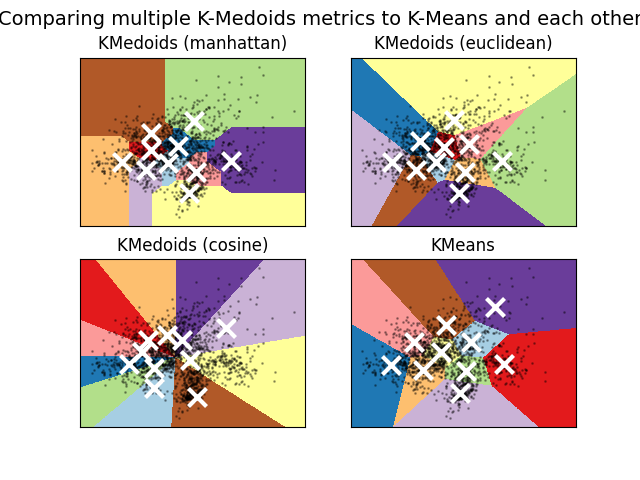Note
Go to the end to download the full example code
A demo of K-Medoids clustering on the handwritten digits data¶
In this example we compare different pairwise distance metrics for K-Medoids.

/home/docs/checkouts/readthedocs.org/user_builds/scikit-learn-extra/envs/latest/lib/python3.10/site-packages/sklearn/cluster/_kmeans.py:1416: FutureWarning: The default value of `n_init` will change from 10 to 'auto' in 1.4. Set the value of `n_init` explicitly to suppress the warning
super()._check_params_vs_input(X, default_n_init=10)
import numpy as np
import matplotlib.pyplot as plt
from sklearn.cluster import KMeans
from sklearn_extra.cluster import KMedoids
from sklearn.datasets import load_digits
from sklearn.decomposition import PCA
from sklearn.preprocessing import scale
print(__doc__)
# Authors: Timo Erkkilä <timo.erkkila@gmail.com>
# Antti Lehmussola <antti.lehmussola@gmail.com>
# Kornel Kiełczewski <kornel.mail@gmail.com>
# License: BSD 3 clause
np.random.seed(42)
digits = load_digits()
data = scale(digits.data)
n_digits = len(np.unique(digits.target))
reduced_data = PCA(n_components=2).fit_transform(data)
# Step size of the mesh. Decrease to increase the quality of the VQ.
h = 0.02 # point in the mesh [x_min, m_max]x[y_min, y_max].
# Plot the decision boundary. For that, we will assign a color to each
x_min, x_max = reduced_data[:, 0].min() - 1, reduced_data[:, 0].max() + 1
y_min, y_max = reduced_data[:, 1].min() - 1, reduced_data[:, 1].max() + 1
xx, yy = np.meshgrid(np.arange(x_min, x_max, h), np.arange(y_min, y_max, h))
plt.figure()
plt.clf()
plt.suptitle(
"Comparing multiple K-Medoids metrics to K-Means and each other",
fontsize=14,
)
selected_models = [
(
KMedoids(metric="manhattan", n_clusters=n_digits),
"KMedoids (manhattan)",
),
(
KMedoids(metric="euclidean", n_clusters=n_digits),
"KMedoids (euclidean)",
),
(KMedoids(metric="cosine", n_clusters=n_digits), "KMedoids (cosine)"),
(KMeans(n_clusters=n_digits), "KMeans"),
]
plot_rows = int(np.ceil(len(selected_models) / 2.0))
plot_cols = 2
for i, (model, description) in enumerate(selected_models):
# Obtain labels for each point in mesh. Use last trained model.
model.fit(reduced_data)
Z = model.predict(np.c_[xx.ravel(), yy.ravel()])
# Put the result into a color plot
Z = Z.reshape(xx.shape)
plt.subplot(plot_cols, plot_rows, i + 1)
plt.imshow(
Z,
interpolation="nearest",
extent=(xx.min(), xx.max(), yy.min(), yy.max()),
cmap=plt.cm.Paired,
aspect="auto",
origin="lower",
)
plt.plot(
reduced_data[:, 0], reduced_data[:, 1], "k.", markersize=2, alpha=0.3
)
# Plot the centroids as a white X
centroids = model.cluster_centers_
plt.scatter(
centroids[:, 0],
centroids[:, 1],
marker="x",
s=169,
linewidths=3,
color="w",
zorder=10,
)
plt.title(description)
plt.xlim(x_min, x_max)
plt.ylim(y_min, y_max)
plt.xticks(())
plt.yticks(())
plt.show()
Total running time of the script: (0 minutes 0.985 seconds)